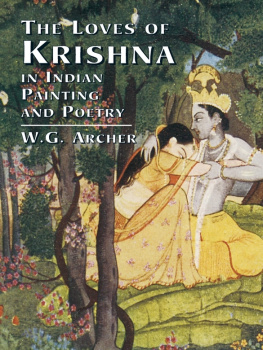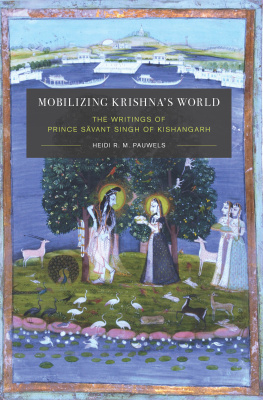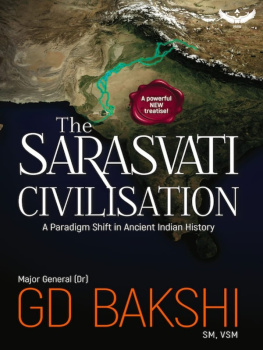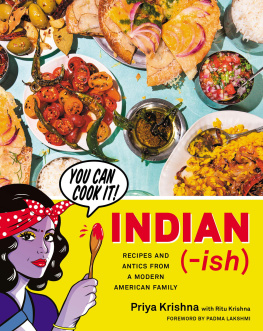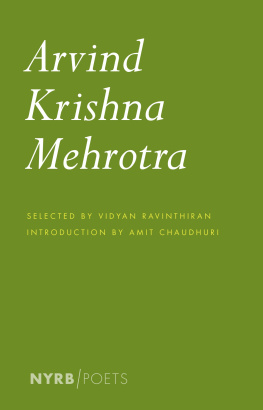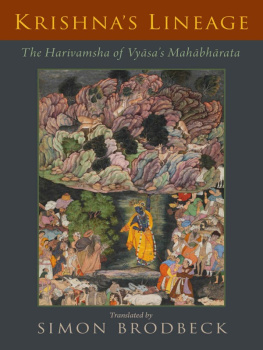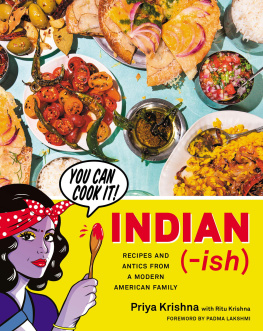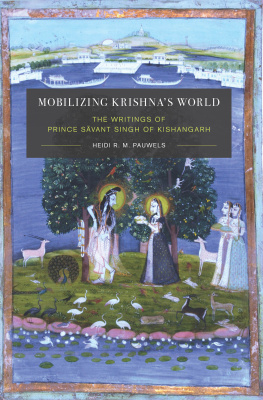W. G. Archer - The Loves of Krishna in Indian Painting and Poetry
Here you can read online W. G. Archer - The Loves of Krishna in Indian Painting and Poetry full text of the book (entire story) in english for free. Download pdf and epub, get meaning, cover and reviews about this ebook. year: 2004, publisher: Dover Publications, genre: Detective and thriller. Description of the work, (preface) as well as reviews are available. Best literature library LitArk.com created for fans of good reading and offers a wide selection of genres:
Romance novel
Science fiction
Adventure
Detective
Science
History
Home and family
Prose
Art
Politics
Computer
Non-fiction
Religion
Business
Children
Humor
Choose a favorite category and find really read worthwhile books. Enjoy immersion in the world of imagination, feel the emotions of the characters or learn something new for yourself, make an fascinating discovery.
- Book:The Loves of Krishna in Indian Painting and Poetry
- Author:
- Publisher:Dover Publications
- Genre:
- Year:2004
- Rating:4 / 5
- Favourites:Add to favourites
- Your mark:
- 80
- 1
- 2
- 3
- 4
- 5
The Loves of Krishna in Indian Painting and Poetry: summary, description and annotation
We offer to read an annotation, description, summary or preface (depends on what the author of the book "The Loves of Krishna in Indian Painting and Poetry" wrote himself). If you haven't found the necessary information about the book — write in the comments, we will try to find it.
The Loves of Krishna in Indian Painting and Poetry — read online for free the complete book (whole text) full work
Below is the text of the book, divided by pages. System saving the place of the last page read, allows you to conveniently read the book "The Loves of Krishna in Indian Painting and Poetry" online for free, without having to search again every time where you left off. Put a bookmark, and you can go to the page where you finished reading at any time.
Font size:
Interval:
Bookmark:
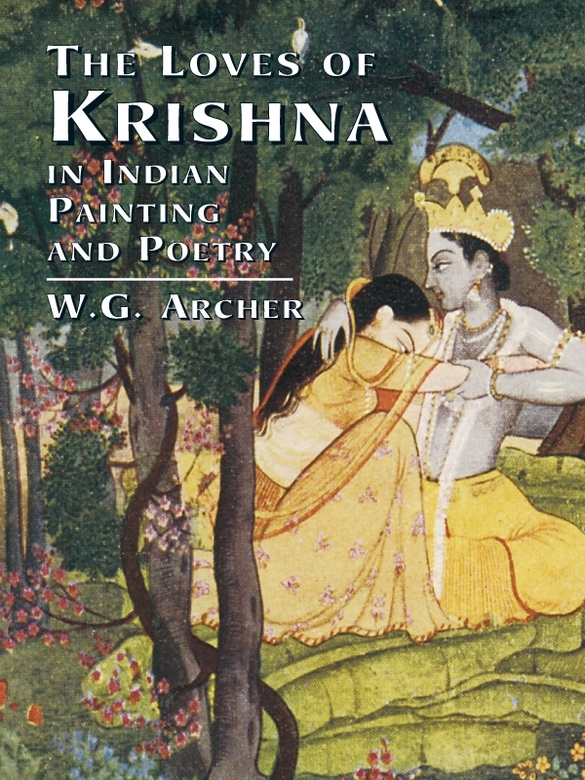
I am deeply indebted to Dr. A. L. Basham for generous guidance throughout the preparation of this book, to George Keyt for permitting me to quote extensively from his brilliant translation of the Gita Govinda , and to Deben Bhattacharya who supplied me with new translations of later poems and discussed a number of important points. I must also express my deep gratitude to Mildred Archer and to Gopi Krishna Kanoria for valued criticism and advice, to Messrs. Faber and Faber, the Harvill Press, Messrs. Macmillan, the Oxford University Press, the Phoenix House and Messrs. Sidgwick and Jackson for permitting me to quote passages from works still copyright, to Professor J. Brough for an informative note on Bhanu Dattas Rasamanjari and to all those owners of collections who have either allowed me to reproduce pictures in their possession or have kindly supplied me with photographs.
Part of the material for this book was delivered as lectures to the Royal Asiatic Society, the Royal India, Pakistan and Ceylon Society and at the Victoria and Albert Museum.
AGRAWALA, V. S.: The Romance of Himachal Paintings, Roopa-Lekha XX, 2, (19489), 8793.
ARCHER, W. G.: Indian Painting in the Punjab Hills (London, 1952). Kangra Painting (London, 1952). Garhwal Painting (London, 1954). Indian Painting (London, 1956).
BASHAM, A. L.: The Wonder that was India (London, 1954).
BURNOUF, E. (trans.): Le Bhagavata Purana (Paris, 184098).
COOMARASWAMY, A. C.: The Eight Nayikas, Journal of Indian Art and Industry , XVI (New Series), No. 128 (1914), 99116. Rajput Painting (Oxford, 1916). Catalogue of the Indian Collections in the Museum of Fine Arts, Boston: Part V, Rajput Painting; Part VI, Mughal Painting (Cambridge, Mass. 1926, 1930). (trans.) The Taking of Toll (London, 1915).
GANGOLY, O. C.: Masterpieces of Rajput Painting (Calcutta, 1926). Ragas and Raginis (Calcutta, 1934).
GRAY, B.: Rajput Painting (London, 1948). Painting, The Art of India and Pakistan , ed. L. Ashton (London, 1950).
GRIERSON, G. A.: The Modern Vernacular Literature of Hindustan (Calcutta, 1889).
HENDLEY, T. H. :Memorials of the Jeypore Exhibition. IV, the Razm Namah (London, 1883).
HOLLINGS, W. (trans.): The Prem Sagur (Lucknow, 1880).
ISHERWOOD, C. and PRABHAVANANDA, S. (trans.): The Song of God , Bhagavad-Gita (London, 1947).
JONES, W. (trans.): Gitagovinda or Songs of Jayadeva, Asiatick Researches (Calcutta, 1792).
KEYT, G. (trans.): Sri Jayadevas Gita Govinda (Bombay, 1947).
MATHERS, E. POWYS (trans.) : Eastern Love (London, 192730). (trans.) Love Songs of Asia (London, 1944).
MAZUMDAR, R. C.: (ed.) The History and Culture of the Indian People, I, The Vedic Age (London, 1951) ; II, The Age of Imperial Unity (Bombay, 1951).
MEHTA, N. C.: Studies in Indian Painting (Bombay, 1926). Gujarati Painting in the Fifteenth Century (London, 1931).
RANDHAWA, M. S.: Kangra Valley Painting (New Delhi, 1954). The Krishna Legend in Pahari Painting (New Delhi, 1956).
ROY, P. C. (trans.): The Mahabharata (Calcutta, 1883).
SEN, D. C.: History of Bengali Language and Literature (Calcutta, 1911).
SEN, R. N. (trans.): The Brahma Vaivarta Purana (Allahabad, 1920).
STCHOUKlNE, I.: La Peinture Indienne (Paris, 1929).
WINTERNITZ, M.: A History of Indian Literature (Calcutta, I, 1927; II, 1933).
WILSON, H. H. (trans.) : The Vishnu Purana (London, 1840).
Note 1, p. 13.
For a further discussion of these two main kinds of Indian expression, see my Indian Painting (Iris, Batsford, London, 1956).
Note 2, p. 14.
In Indian painting, Krishna is normally blue or mauve in colour, though cases occur in which he is black, green or dark brown. Black would seem to follow from Krishnas namethe word Krishna meaning blackand may have been applied either because he sprang from a black hair of Vishnu or because he was born at midnight, black as a thundercloud. It has been suggested that his dark complexion proves a Dravidian or even an aboriginal origin since both the Dravidian races and the aboriginal tribes are dark brown in colour in contrast to the paler Aryans. None of the texts, however, appears to corroborate this theory. So far as blue and mauve are concerned, blue is the colour of Vishnu and characterizes most of his incarnations. As the colour of the sky, it is appropriate to a deity who was originally associated with the sunthe sun with its life-giving rays according well with Vishnus role as loving protector. Blue is also supposed to be the colour of the ocean on which Vishnu is said to recline at the commencement of each age. In view of the variations in colour in the pictures, it is perhaps significant that blue, mauve and green are commonly regarded in village India as variants of blackmany Indians making no distinction between them. In Indian painting, the fact that Krishna is blue makes it easy to identify him, his only serious rival being another and earlier incarnation of Vishnu, the princely Rama. The latter can usually be distinguished from Krishna by the fact that he carries a bow (never a cowherds stick) and is often accompanied by Hanuman, the monkey leader.
Note 3, p. 17.
For a comparison of Ghora Angirasas teaching in the Chandogya Upanishad with Krishnas precepts in the Gita, see Mazumdar, The Age of Imperial Unity (4324) and Basham, The Wonder that was India (2427, 3045).
Note 4, p. 17.
Although the actual date of the Mahabharata war has been variously assessedbetween 1400 and 1000 B.C. (M. A. Mehendale in The Age of Imperial Unity, 251) the beginning of the ninth century B.C. (Basham, op. cit., 39)the epic itself is generally recognized as being a product of many centuries of compilation. The portions relating to Krishna the hero may well date from the third century B.C. The Gita, on the other hand, was possibly composed in the second century B.C. but assumed the form in which it appears in the Mahabharata today in the early centuries A.D. (Mehendale, op. cit., 249).
Note 5, p. 24.
The implication is that the Pandavas have not been granted ultimate salvation i.e. final release from living but have reached the important transitional level of the heaven of the doers of good deeds. They have also been granted the limited status of petty gods.
Note 6, p. 25.
Harivansa, the Genealogy of Krishna but more literally, the Genealogy of Hari, a synonym for Vishnu. For the sake of clearness and to avoid burdening the text with too much periphrasis, I have throughout referred to Krishna as such. In the texts themselves, however, he is constantly invoked under other namesHari (or Vishnu), Govinda (the cowherd), Keshava (the hairy or radiant one), Janarddana (the most worshipful), Damodara (bound with a rope, referring to the incident (p. 32) when having been tied by Yasoda to a mortar, Krishna uproots the two trees), Murari (foe of Mura, the arch demon p. 58) or in phrases such as queller of Kaliya the snake, destroyer of Kesi, the demon horse, slayer of Madhuthe demon who sprang from the ear of Vishnu and was killed by him. A similar use of periphrasis occurs in Anglo-Saxon kennings (world-candle for sun, battle-adders for arrows). In the same way, Abul Fazls chronicle, the Akbarnama , never names the emperor Akbar but refers to him in terms such as His Majesty, the holy soul, lord of the age, fountain of generosity, the sacred heart, the world-adorning mind, the decorated mansion of sports.
Note 7, p. 26, 34, 46, 68, 69.
In Chapters 3 and 4 I have, in the main, strictly followed the Bhagavata Purana, incorporating, however, a few important details and passages either not given in this text but included in the Vishnu Purana or if given, not so vividly expressed. The details and passages in question are page 27 concerning the white and black hairs of Vishnu, page 34the lyrical description of Krishnas life in the forest, page 46Akruras meditation as he goes to visit Krishna, page 68the drunken brawl and page 69 the deaths of Balarama and Krishna. All extracts are from H. H. Wilson, The Vishnu Purana (pages 498, 511, 5412, 609612).
Font size:
Interval:
Bookmark:
Similar books «The Loves of Krishna in Indian Painting and Poetry»
Look at similar books to The Loves of Krishna in Indian Painting and Poetry. We have selected literature similar in name and meaning in the hope of providing readers with more options to find new, interesting, not yet read works.
Discussion, reviews of the book The Loves of Krishna in Indian Painting and Poetry and just readers' own opinions. Leave your comments, write what you think about the work, its meaning or the main characters. Specify what exactly you liked and what you didn't like, and why you think so.

